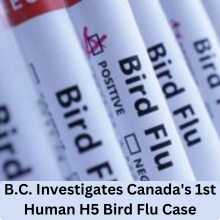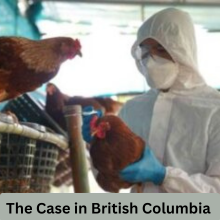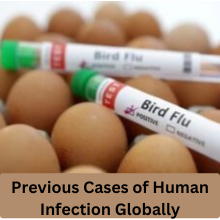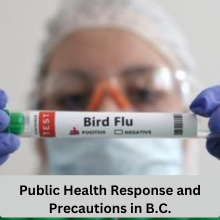
Canada is currently investigating its first suspected case of H5 avian influenza in a human. This case, which emerged in British Columbia, has garnered significant attention from health authorities across the country. Health officials are examining the situation closely, as the potential for the virus to spread to humans is a public health concern.
While the risk of widespread human-to-human transmission remains low, experts are monitoring the situation to ensure there is no escalation. The case involves a teenager from the Fraser Health region, who has been hospitalized at B.C. Children’s Hospital. As health officials work to confirm the diagnosis, they are also looking to trace the virus’s origins and potential sources of exposure.
What is H5 Avian Influenza?
H5 avian influenza, also known as bird flu, is a viral infection that primarily affects birds, especially poultry. The virus can sometimes cross over into humans, though such occurrences are rare. H5N1, the most well-known strain of avian influenza, has been a cause of concern globally due to its potential to cause significant harm in humans.
Bird flu viruses like H5 are typically spread through direct contact with infected birds or their environments. This could include handling contaminated surfaces, such as bird cages or coops, or coming into contact with sick or dead birds. Most human cases of avian influenza have occurred in regions where poultry farming and live bird markets are prevalent.
Symptoms of H5 Bird Flu in Humans
In humans, avian influenza can cause a variety of symptoms ranging from mild to severe. These symptoms can be similar to those of the common flu, such as fever, cough, sore throat, and muscle aches. However, in more serious cases, the infection can lead to severe respiratory issues, including pneumonia, organ failure, and even death.
The severity of the disease in humans depends on factors such as the strain of the virus, the person’s overall health, and how quickly treatment is administered. Health officials are particularly concerned about certain strains, such as H5N1, because of their ability to cause severe illness and death.
How Do Humans Contract Avian Flu?
Humans usually become infected with avian flu through close contact with infected birds or a contaminated environment. This can happen in poultry farms, live bird markets, or even in rural areas where infected birds are present. In rare cases, human-to-human transmission has been reported, though this is not common.
The risk of human infection increases for people who work closely with poultry, such as farmers, veterinarians, and others in the agricultural industry. This is why outbreaks of avian influenza are often closely monitored by public health authorities, particularly in areas where poultry farming is prevalent.
The Case in British Columbia
The teenager from British Columbia who is believed to have contracted the H5 avian flu is currently receiving treatment at B.C. Children’s Hospital. The Ministry of Health in British Columbia has confirmed that the case is presumptive, meaning that while the symptoms suggest avian influenza, further tests are needed to confirm the diagnosis.
Health officials are working diligently to identify the source of the infection and determine if there were any other people exposed to the virus. At present, no additional human cases have been identified. Public health officials are reassuring the public that the risk remains low, though they are taking all necessary precautions to prevent further spread.
Investigating the Source of Exposure
Understanding how the teenager contracted the virus is a priority for health authorities. B.C. has been experiencing outbreaks of H5N1 in poultry farms and wild birds, which may be linked to the infection. However, officials are also considering other potential sources of exposure, including contact with small mammals or other animals.
The provincial health officer, Dr. Bonnie Henry, emphasized that the investigation is still in its early stages, and further information will be shared as it becomes available. Public health officials are also monitoring contacts of the infected individual to ensure that any potential cases are identified quickly.
H5N1 and Its Global Impact
H5N1 avian influenza is not a new threat. First identified in the late 1990s, the virus has caused widespread concern due to its potential to evolve into a strain capable of causing a human pandemic. Since then, there have been various outbreaks in both birds and humans, particularly in Asia, Africa, and parts of Europe.
The H5N1 virus is highly pathogenic in birds and can spread rapidly among poultry populations. When the virus jumps to humans, it can cause severe illness, with a high fatality rate. Although human-to-human transmission remains rare, the virus has been monitored closely due to its potential for mutation.
Previous Cases of Human Infection Globally
Since the emergence of H5N1 in the late 1990s, more than 900 cases have been confirmed worldwide. The majority of these cases have occurred in Asia, with a significant number in countries like Vietnam, Indonesia, and China. The mortality rate for H5N1 infections has been high, with roughly half of the reported cases resulting in death.
However, many experts believe that the actual number of human infections may be higher, as mild cases may go undetected or unreported. Even with these concerns, it’s worth noting that human-to-human transmission has remained relatively rare, making large-scale outbreaks unlikely.
The Role of Wild Birds and Poultry Farms in Transmission
Poultry farms and wild birds are the primary sources of H5N1 outbreaks. Infected birds can shed the virus in their saliva, feces, and nasal secretions, which can contaminate the environment and spread to other birds, as well as humans. In some cases, wild birds act as carriers, migrating between countries and continents, thus spreading the virus.
In B.C., the virus has been detected in poultry farms and wild birds, leading to concerns that human exposure may occur. The recent case in British Columbia serves as a reminder of how the virus can cross species boundaries and potentially cause human infections.
Monitoring the Spread Among Animals
Since early October, the H5N1 virus has been detected in various animal species in British Columbia, including wild birds, poultry, and small mammals like foxes and skunks. These animals play an important role in the virus’s transmission cycle, and health officials are closely monitoring animal populations for signs of further infection.
Infected animals, particularly wild birds, can spread the virus over long distances. This is why public health officials are urging residents to report sick or dead birds, as this can help limit the virus’s spread and prevent further human exposure.
Public Health Response and Precautions in B.C.
In response to the confirmed cases of avian influenza in animals, B.C. health officials have issued public warnings about the potential for human exposure. They have advised residents to avoid direct contact with sick or dead animals, particularly wild birds, and to take precautions when handling animals on farms.
Health authorities are also urging people to report any dead or ill birds or mammals to provincial authorities so that they can be tested for avian influenza. This will help health officials track the virus’s spread and take steps to contain it.
Also read: Colorado’s 3-Foot Snowstorm Closes Major Highways
What Residents in B.C. Should Do
If you live in British Columbia, especially in areas where avian influenza outbreaks have been detected, it’s important to take certain precautions. Avoid handling sick or dead birds, and ensure that your pets are not exposed to potentially infected wildlife. If you encounter a sick or dead animal, contact local authorities to report it.
Additionally, if you work in poultry farming or have had direct contact with birds, it’s essential to monitor your health and seek medical attention if you develop flu-like symptoms. Early detection and treatment can help prevent the virus from causing severe illness.
Why is H5N1 a Concern for Global Health?
H5N1 is considered a major global health concern because of its potential to mutate and become more easily transmissible between humans. If this were to happen, it could lead to a widespread pandemic, affecting millions of people worldwide. Scientists and health officials are closely monitoring the virus to detect any signs of such a mutation, which could pose a serious threat to public health.
Could H5N1 Mutate to Be More Easily Transmissible?
The possibility of H5N1 mutating to become more easily transmissible between humans is a major concern for health experts. Viruses like H5N1 are capable of undergoing genetic reassortment, which means they can swap genes with other viruses, potentially making them more contagious. This is why continued surveillance of both animal and human cases is critical to preventing a potential pandemic.
The Current Status of Avian Flu in North America
In recent months, both Canada and the U.S. have seen a rise in avian flu cases. In Canada, over 22 poultry farms in B.C. have been affected by H5N1, and numerous wild birds have tested positive for the virus. In the U.S., there have been more than 40 human cases of bird flu, most of them linked to exposure in farms or poultry processing plants.
As the virus continues to spread among animals, health authorities in both countries are on high alert, monitoring the situation closely and preparing for any potential human outbreaks.
The Future of Bird Flu: Risks and Measures to Contain It
The future of bird flu remains uncertain, but the risk of a large-scale outbreak cannot be ignored. Global cooperation will be crucial in controlling the spread of the virus and preventing human infections. Efforts to improve surveillance, increase public awareness, and develop effective vaccines will be essential in minimizing the threat.
Also read: Why ChatGPT Is Down & When the ‘Bad Gateway’ Error Will Be Fixed
Conclusion
The detection of Canada’s first presumptive human case of H5 bird flu in British Columbia underscores the ongoing risks posed by avian influenza. While human cases remain rare, the potential for the virus to evolve into a more transmissible form is a concern for global health. It is essential that both public health authorities and residents take precautions to limit exposure and prevent further spread of the virus. The situation remains fluid, and ongoing investigations will provide more information on how to best manage and mitigate the risks associated with H5 avian influenza.
FAQs
-
What is H5N1 avian influenza, and how dangerous is it to humans?
- H5N1 is a strain of avian influenza that primarily affects birds but can occasionally infect humans. It is dangerous because it can cause severe illness in humans, with a high fatality rate.
-
How is the current case in B.C. being handled by health officials?
- Health officials are investigating the source of the infection and monitoring the teenager’s contacts for any potential symptoms. No additional human cases have been identified.
-
Can H5 bird flu spread easily among humans?
- Currently, human-to-human transmission of H5 bird flu is rare. However, if the virus mutates, it could potentially become more easily transmissible.
-
What should residents do if they find dead or sick birds?
- Residents should avoid handling sick or dead birds and report them to local authorities for testing. This helps prevent the spread of avian flu.
-
How can we prevent the spread of H5 avian influenza in the future?
- Preventative measures include avoiding contact with infected animals, monitoring for symptoms in at-risk populations, and global cooperation to improve surveillance and vaccine development.


